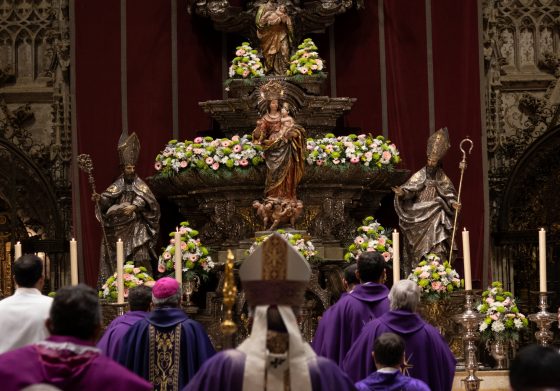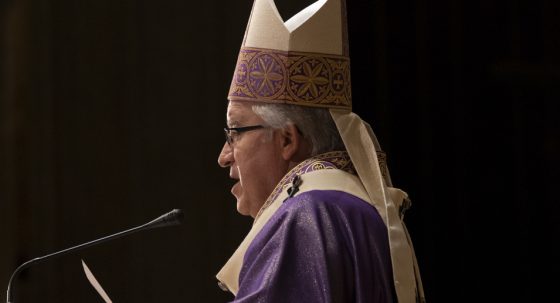‘Look, I make all things new’. This passage from the Apocalypse is the one chosen by the Archbishop of Seville, Monsignor José Ángel Saiz Meneses, to title the letter he wrote at the beginning of the liturgical year. It is an extensive document (47 pages) that sees the light of day at the same time as the Diocesan Pastoral Plan for the next five years, and that is published after a year and a half of Monsignor Saiz Meneses’ episcopate in Seville, “an immersion as wide as intense that has allowed me to know many realities of diocesan life”. Both the letter and the Pastoral Plan were presented at the Mass that was celebrated in the Cathedral last Sunday.
The archbishop trusts that at the end of this course it will be possible to achieve a “normalization of practically all of our pastoral activity”, facing new challenges. He believes that he is not starting from scratch, and notes that he shepherds a diocese “that has been on the road for many centuries and remains full of vitality.” This is how he expresses it in the introduction to a letter that consists of three parts in which he delves into today’s society –’A society in constant change’-, the announcement of the Word of God to the world and evangelization as an essential mission of the Church. .
A society in constant change
 Monsignor Saiz Meneses starts from an analysis of “the reality that has to be evangelized.” And for this he begins by realizing the changes at all levels that end up configuring a reality with its lights and shadows. The prelate cites a series of “rapid and profound changes that affect the human being, divided between hope and vertigo in the face of so many novelties.” He cites Bauman, who coined the metaphor of the liquid society, to describe current times, and exposes different passages from the magisterium of the last pontiffs in which the awareness of the Church in relation to the impact that these changes were going to stand out. producing both in the faithful people and in society.
Monsignor Saiz Meneses starts from an analysis of “the reality that has to be evangelized.” And for this he begins by realizing the changes at all levels that end up configuring a reality with its lights and shadows. The prelate cites a series of “rapid and profound changes that affect the human being, divided between hope and vertigo in the face of so many novelties.” He cites Bauman, who coined the metaphor of the liquid society, to describe current times, and exposes different passages from the magisterium of the last pontiffs in which the awareness of the Church in relation to the impact that these changes were going to stand out. producing both in the faithful people and in society.
The anthropological challenge, the need for evangelizers in the world of culture or an economy based on ethics and the common good, are some of the scenarios raised by the Archbishop of Seville in this analysis of reality. In this section, he also does not forget the management of new technologies – “the digital community is like a swarm full of isolated cells”, he stresses, quoting Byung-Chul Han-, sustainability and care for our common home.
The archbishop draws attention to the situation facing the Christian family: “The current socioeconomic model (…) causes the family to experience a shock that affects its presence and its mission in the whole of the human family.” Next, he refers to the latest FOESSA Report to highlight the social risks that derive from an economic crisis with such a severe and prolonged impact. In this sense, he warns of the danger that the new situations of poverty and exclusion become structural.
The Church is also undergoing great transformations, “in the context of a dramatic drop in the birth rate.” But he points out that the difficulties that the Church has to face come from abroad, “from the surrounding culture”, and from within itself, “from internal secularization, from a lack of communion or from missionary audacity”. However, Monsignor Saiz appreciates the growth in the number of lay people who actively participate in the mission of the Church. “Her convinced and convincing testimony is a reason for hope,” he adds.
“Go to the whole world and proclaim the Gospel to all creation”
“The Church has been sent to announce the Gospel to those who still do not know Jesus Christ, and also to those who have been baptized but need a new evangelization.” With this statement begins the second part of the letter, which lists the various areas of action, and notes that this mission entails “the radical need for a comprehensive conversion not only of people, but also of our institutions” . When the archbishop speaks of testimony, he is not referring only to that which is offered through words, “but also to that which is manifested with life.” The objective is that all areas of the Archdiocese become “healing reception spaces and encounters with Christ, in the manner of Samaritan Churches”. In this section, Don José Ángel delves into the different levels of conversion: personal, community and pastoral.
The Gospel we proclaim
 The existence of the Church makes sense to the extent that it “announces, preaches and teaches the Gospel”. This is the axis of the third part of the letter, in which Monsignor Saiz details some responses that the Church proposes for evangelization. Given the lack of meaning, liquidity and detachment, the archbishop proposes the testimony of Christian life. In addition, facing the relativism and subjectivism of the dominant society, he proposes “to make Jesus known”; in the face of poverty and the challenges posed by immigration, “to be witnesses of God’s mercy”; Faced with the digital swarm to which he alluded at the beginning of the letter, he brings “the friendship lived in the Christian community”; And as a response to the challenges posed by the future of the planet, the Archbishop of Seville postulates an ecological conversion that must start from dialogue and collaborative work.
The existence of the Church makes sense to the extent that it “announces, preaches and teaches the Gospel”. This is the axis of the third part of the letter, in which Monsignor Saiz details some responses that the Church proposes for evangelization. Given the lack of meaning, liquidity and detachment, the archbishop proposes the testimony of Christian life. In addition, facing the relativism and subjectivism of the dominant society, he proposes “to make Jesus known”; in the face of poverty and the challenges posed by immigration, “to be witnesses of God’s mercy”; Faced with the digital swarm to which he alluded at the beginning of the letter, he brings “the friendship lived in the Christian community”; And as a response to the challenges posed by the future of the planet, the Archbishop of Seville postulates an ecological conversion that must start from dialogue and collaborative work.
At this point he lists a list of attitudes to undertake the evangelizing task, based on prayer and the primacy of grace as an essential theological principle. The evangelizer must live a strong and deep spirituality, with a life of intense prayer nourished by the Word of God and the sacraments. In addition, he must have a sense of Church. The archbishop stops here to explain that in the current situation we cannot live the faith and the apostolate individually.
Another attitude of the evangelizer is “to walk in truth and humility”: “In the midst of a liquid society – he points out – the Christian must be a consistent and firm subject”. And both joy and hope must be defining traits of the evangelizer’s personality. Why? Because “he who meets Christ finds a hidden treasure.”
A separate chapter deserves the exercise of charity. Monsignor Saiz underlines the validity of the Christian’s commitment to the joys and sorrows of the man of our time: “Loving, compassionate, helping brothers in need, is something essential for the Church, it is part of her deepest nature.”
Agents and spheres of evangelization
Finally, the letter points out which are the evangelizing agents: the bishop with his presbytery, the consecrated life and the laity. Three evangelization situations are also detailed, beginning with ordinary pastoral action, continuing with the “new evangelization” with those who are far away and concluding with the mission ad gentes. In this field, Don José Ángel specifically mentions young people, situations of poverty, the “areopagus of culture” and the world of communication. “The missionary mandate remains valid in a world in which the influence of the media and social networks is increasingly decisive in the religious, psychological and moral development of people, in political and social systems, in the perception and transmission of values, in education”, he concludes.
Monsignor Saiz bets on a renewed evangelizing impulse at the beginning of the liturgical year

